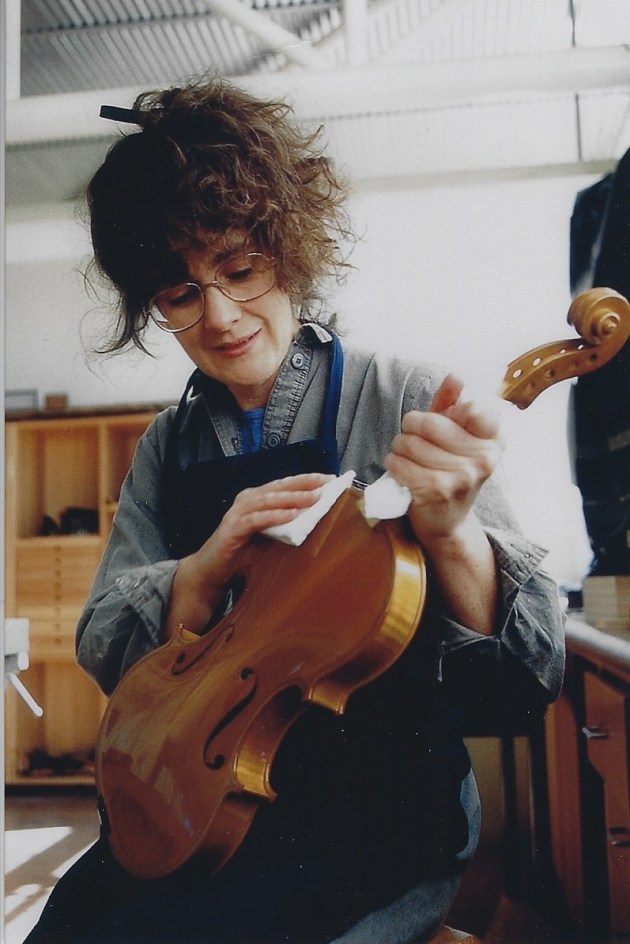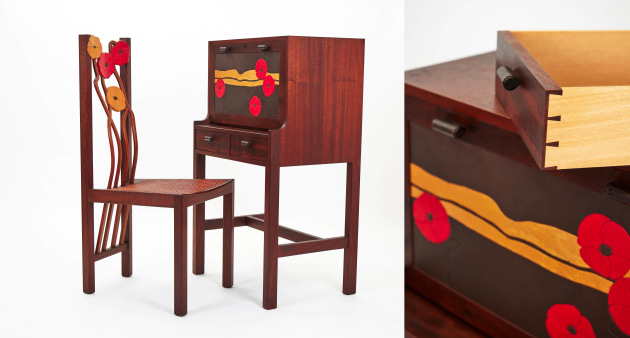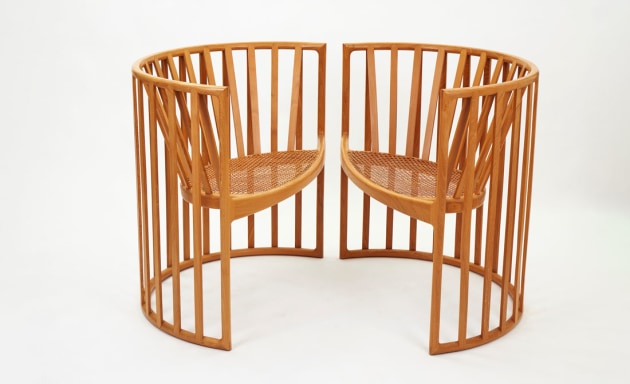Pru Ingham: A Creative Life
Born September 17, 1943, Pru Ingham was a designer maker and teacher of woodworking who sadly passed away last year. She died as she wished, on the eleventh day of the eleventh month in 2022.
Pru was born in Sydney at the height of World War II and spent her childhood in the Blue Mountains. She learned violin from an early age and always had ‘clever hands’ for crafts and making things. She went on to study music at Sydney University as part of an Arts degree, but left before completing her degree.
In the early years of her first marriage Pru lived in Alice Springs – her children Cate, Peter and Rachel Shaw were born during that time. ‘We lived in a creek bed in a tent near Tennant Creek’, said Cate. ‘Pru was a great problem solver and we were all very in tune with the land.’
In 1981 Pru enrolled in a Canberra TAFE woodwork course where her outstanding talents with wood were quickly recognised and she was persuaded to interview for the fine woodworking course that was established by George Ingham at the ANU School of Art (SOA) in 1982. She was admitted on the basis of her pottery portfolio.
Above: Poppy Writing Desk and Chair, c.1983, features painted motifs and leather panel.
In 1986 she was commissioned to design and make benches for the Australian National Gallery. From that time, Pru also became partner and later collaborator to George Ingham. In the following years she undertook many commissions and participated in exhibitions. In 1991 Pru started teaching her ground-breaking ‘woodwork for women’ classes.
Pru cared for George after devastating surgery for cancer in 1998 until his death in 2003. She lived on alone at Mongarlowe, working on finishing their house, and living off the land until her health declined. Pru spent the end of her life living with her
sister and daughter, and grandchildren in Canberra.
Here, her daughter Cate Shaw, close friend David Mac Laren OAM, and two of Pru’s former students reflect on her life, the perfection and creativity of her work, and the quiet influence she had on others.
A pair of chairs in salvaged elm made in c.1998
Notes from a daughter
Pru grew up in the Blue Mountains and her playground was the Australian bush, in the dappled light of the creek that ran behind their house. Pru always appreciated and loved the tensions of that landscape, the light and shade, the harshness/strength of the bush and the delicacy of flowers, spiderwebs, dew drops – fragile structures fascinated her. She enjoyed the juxtaposition of random pattern and structure.
In her furniture design she loved slats, the interplay of positive and negative that makes structure transparent and light. Her signature is the tea tree blossom of Mongarlowe.
Cate Shaw is a Canberra-based architect, cross-disciplinary designer and design educator.

Two views of Conviviality Chair, 1997, wenge, glass, leather
Reflections from a friend
To walk into the Canberra School of Art Wood Workshop, into George Ingham’s arcane and demanding world as a mature student, Pru Shaw was indeed a rare person to completely and quickly get it. One can only imagine George’s delight, as a teacher, to encounter such a gift. And to imagine that special focus George would have bestowed towards Pru. And that in turn would have given Pru the confidence and permission to go all out in her application to her newly discovered craft.
There can be a loneliness of teaching at George’s level, and I think a special bond developed rather quickly between the two. To move from student to partner in making is a rare treat for both teacher and student. And for this bond to move even further towards collaboration, and then love, is simply remarkable. But these two were remarkable people.
Both were disciplined at work; both were precise and articulate in conversation and making. Both enjoyed a quick-witted humour. If anything, Pru was less constrained by craft’s regime, she could break out with surprising colours and materials rarely found in craft’s tradition.

Writing Box, 1998, wenge with epoxy resin inlay
I did remark at some point towards the end of George’s life that I thought Pru introduced a flourishing in George’s work, that resulted in the introduction of bold colour to some of his outstanding pieces. They both smiled but did not comment, I think preferring to keep that commentary within their world. It is however what I prefer to believe.
For them to then embark on building a house together, their home, on rough land in Mongarlowe, Braidwood, a house self sufficient in energy use, with wind and batteries, and a workshop within the house (!), would have been a pioneering adventure requiring a deep closeness of sensibilities of their evolving partnership.

Detail of Writing Box, 1998, wenge with epoxy resin inlay
They loved living in their home, and spending time in their garden, and doting on making their home a stunning gallery for their works. I so wish there was a way their gallery/home could be open to the interested public. Alas we do not have a sophisticated cultural polity to make that happen.
I think George reached out to me late in his illness because he knew I had a history of chronic illness, Crohn’s disease. I visited George and Pru on many Sundays at their Mongarlowe home while George struggled with his cancer. Often medicated he would sleep. Pru and I would make tea and talk of her childhood in the Blue Mountains, and her difficult time with two very young children on the outskirts of Alice Springs.
George built a spiral staircase towards the end, and I marvelled at his discipline to overcome pain and to keep going. When it was finished, we celebrated one Sunday morning. We sat upstairs with the warm sun comforting us. Here was his very impressive collection of handplanes arranged on a long shelf. Pru served breakfast. We were happy together.
Robert, George’s brother, visited from England one Sunday. We sat on George’s bed, and sipped pink Champagne.

Pru Ingham repairing a caned chair at Mongarlowe during lockdown 2020
The last Sunday Pru had been up all night with George, I was not feeling the best, and George was quiet, within himself. Pru and I lay on either side, on the bed, next to George. That was nice. Then it came. George said: ‘This is it’. Ambulance arrived. ‘I won’t be back here he whispered.’ That night he was with his family, Cate and Rachel, and others, at the hospice. I left then and said goodbye to the night.
Recently, Cate (Pru’s daughter), reminded me Pru was an extraordinary maker because her making kept being interrupted, first as a parent, then being George’s carer for four years, and after he died, to look after grandchildren. This was, is, the plight of many female makers/artists, to balance the obligations of their gender with their creative practice.
Had Pru begun her woodworking career early in life, I believe her portfolio of making would have rivalled many of the top makers in the world, irrespective of gender.
David Mac Laren OAM, designer maker and owner/artistic director of Bungendore Wood Works Gallery, NSW.

Conviviality Stool, 1998, wenge, leather
Pru Ingham, teacher
In 1992, Pru, who herself was a graduate of ANU’s School of Art, started teaching her first fine woodwork for women’s course at the ANU School of Art. It was aimed at teaching women who had never before done any woodwork. The first project was fairly ambitious...making a beautifully designed tray with unusual hand chiseled joints.
This project was not an easy first attempt for anybody, but the atmosphere in the class was so supportive that when women sawed their first straight line across a piece of wood, they received a cheer from all the participants. Pru was a very patient and skilled teacher who guided everybody through each step and the results were perfection!
The class was so successful that it was repeated for quite a few years with different groups making different projects. Many women in her classes were so inspired they went on to enrol in the full-time Wood course at the School of Art.

A tray designed by Pru in 1992 as a teaching piece for her woodwork for women classes.
Pru was a highly skilled woodworker and cabinetmaker. She was also an artist. She always added a unique touch and a beautiful aesthetic to her work as well. One beautiful example of this is a desk she made. The chair was like no other chair I had ever seen; hand woven seat, inlaid leather flowers and also totally comfortable to sit on!
The desk drawers had two types of wood that could not touch together until the final join lest the pale wood be stained by the darker. The intricate dovetail joints are faultlessly precise, yet the chair and desk still give a sense of whimsical fun.
Although Pru’s work did not become as nationally known as some of her male counterparts, those who visit the National Gallery to this day, will be sitting on benches that Pru made.

Set of nine spice boxes (detail), 2000, with spline joints and embossed tea tree motifs.
Tashi Long, former student
I’m sure I speak for all the female students who went through the ANU furniture workshop when I say that Pru was a huge inspiration to us. She was living proof not only that ‘women can’, but that ‘women can excel’.
Her skills and talent as a furniture designer and maker were enormous and her generosity and patience as a teacher exceptional. ‘Pru’s here!’ – the word would go around the full-time students if she arrived early for the evening classes she taught.
Her presence in the workshop was always a delight.
Pat Bailey, former student
Studio photography: Andrew Sikorski

Detail of Writing Box interior, 1998, wenge with epoxy resin inlay





